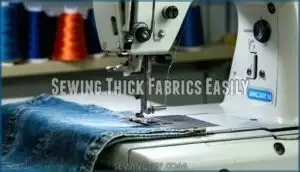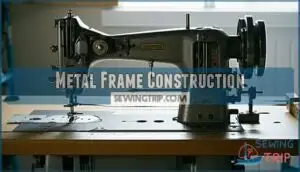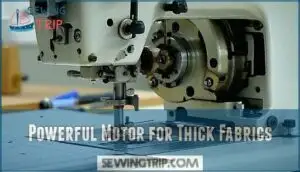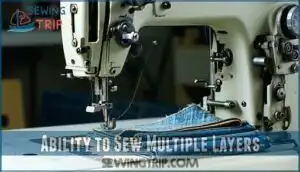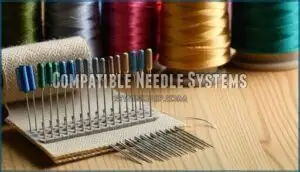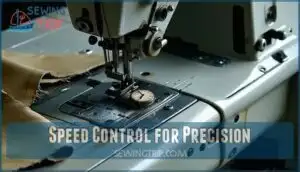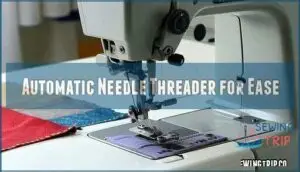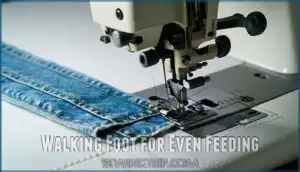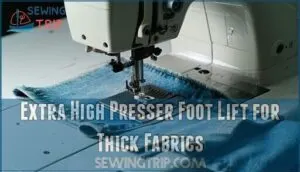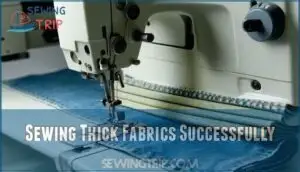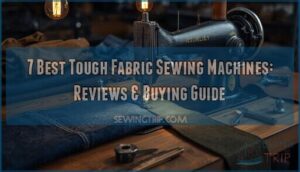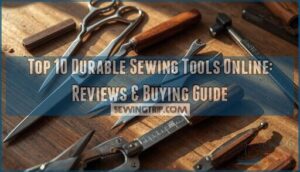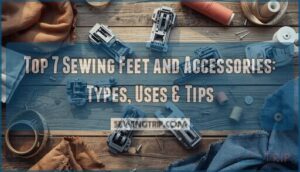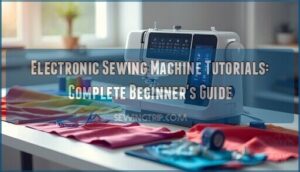This site is supported by our readers. We may earn a commission, at no cost to you, if you purchase through links.
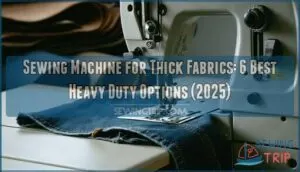 If you’re working with thick fabrics like denim, leather, or upholstery, you’ll need a sewing machine built for the job.
If you’re working with thick fabrics like denim, leather, or upholstery, you’ll need a sewing machine built for the job.
Look for one with a strong motor, a metal frame, and features such as an adjustable presser foot, walking foot, and high stitch-per-minute capacity.
Models like the SINGER Heavy Duty 4432 or the Juki TL-2010Q are designed to handle tough layers without skipping stitches.
Don’t forget a heavy-duty needle and thread—they’re the unsung heroes here.
With the right setup, even challenging projects will feel like sewing a simple cotton swatch, and you’ll be ready to master thick fabrics and get stitching smarter!
Table Of Contents
Key Takeaways
- Look for a sewing machine with a strong motor, metal frame, and walking foot to handle thick fabrics easily.
- Use heavy-duty needles and compatible thread to prevent skipping stitches or breakage.
- Adjust tension, stitch length, and presser foot pressure for smooth, even stitching on bulky materials.
- Consider accessories like an extension table, high presser foot lift, and automatic needle threader to simplify working with tough layers.
Sewing Thick Fabrics Easily
Sewing thick fabrics requires the right tools and techniques to handle heavy layers without strain. With a sturdy machine and proper settings, you can achieve smooth, precise stitches every time.
Sew thick fabrics effortlessly with the right tools, a sturdy machine, and perfectly adjusted settings for smooth, professional results every time.
Choosing The Right Machine
When picking a heavy duty sewing machine for thick material sewing, weigh mechanical vs. computerized options based on control and ease.
Look for strong motors, stitch variety, and budget-friendly models.
Warranty length matters—longer coverage means added assurance. Sturdy build quality is essential for stability.
For industrial sewing or the best sewing machine for heavy fabrics, balance these factors to match your needs.
Key Features for Thick Fabrics
A heavy-duty sewing machine needs strong motor strength, a sturdy frame material, and excellent fabric feeding.
Look for needle compatibility to handle thick material sewing smoothly. A walking foot sewing machine or compound feed sewing machine improves control.
An adjustable presser foot guarantees even stitching, especially with bulky layers. These features make sewing machine for heavy fabrics much easier and reliable.
Tips for Smooth Stitching
Smooth stitching on thick fabrics isn’t tricky with these simple sewing techniques.
Start with the right tools and settings for your sewing machine for thick fabrics:
- Adjust tension for balanced stitches—too tight can break threads.
- Set stitch length slightly longer for durability.
- Use a strong needle designed for thick fabrics.
- Verify that feed dogs and presser foot grip layers evenly for smooth feeding.
Top 6 Sewing Machines
If you’re tackling thick fabrics, finding a reliable sewing machine is essential. Explore these six heavy-duty options, each designed to handle tough materials with precision and ease.
1. SINGER Heavy Duty Sewing Machine Kit
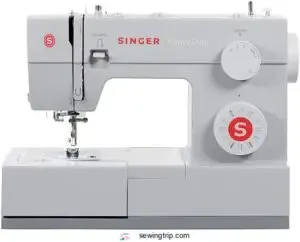
The SINGER Heavy Duty Sewing Machine Kit is a game-changer for tough fabric projects.
A game-changer for tough sewing projects, delivering power, speed, and stability to tackle heavy fabrics with effortless precision.
Its 1,100 stitches-per-minute speed and 60% stronger motor handle thick seams effortlessly, while a sturdy metal frame guarantees stability.
The top drop-in bobbin simplifies threading and prevents jams, and accessories like the zipper foot, buttonhole foot, and seam ripper make it versatile.
The StayBright LED light guarantees clear visibility, and whether you’re tackling denim or canvas, this machine delivers professional results with ease.
It’s durable, efficient, and perfect for heavy-duty sewing tasks.
Best For: Beginners and experienced sewers looking for a durable, high-speed machine that handles heavy fabrics with ease.
- 1,100 stitches-per-minute speed for fast sewing.
- Sturdy metal frame ensures stability and durability.
- Top drop-in bobbin prevents jams and simplifies threading.
- Automatic threader can be cumbersome to use.
- Limited decorative stitch options compared to advanced machines.
- Not as portable due to its heavy-duty metal frame.
2. Brother ST371HD Strong Sewing Machine
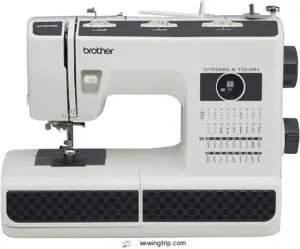
The Brother ST371HD is a reliable, sturdy choice for thick fabrics.
With 37 built-in stitches, a metal needle plate, and a maximum speed of 800 stitches per minute, it handles heavy-duty projects with ease.
Its automatic needle threader and drop-in top bobbin save time and frustration, while the free arm makes sewing sleeves and cuffs a breeze.
The six included presser feet, such as the spring-action zigzag and nonstick options, guarantee versatility.
It’s perfect for beginners and advanced sewists alike.
The machine also features a drop feed system for free-motion sewing.
Best For: Beginners and advanced sewists needing a reliable machine for versatile and heavy-duty projects.
- Sturdy and durable design for thick fabrics and heavy-duty use
- 37 built-in stitches and automatic threader for efficient sewing
- Free arm and various presser feet for versatile project options
- Pedal may overheat during extended use
- Voltage limit may require an adapter outside the US
- Plastic body may feel less premium than full-metal models
3. Juki TL-2010Q Sewing Quilting Machine
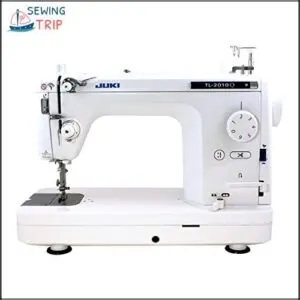
The Juki TL-2010Q is a powerhouse for thick fabrics and quilting.
Its solid, metal construction guarantees stability, while the straight-stitch design focuses on precision.
With speeds up to 1,500 stitches per minute, it handles multiple layers like a breeze.
The included extension table gives you more space for bulky projects like quilts.
Features like the knee lifter and automatic thread cutter save time and effort.
Though it’s heavy and straight-stitch-only, this machine delivers unmatched performance for heavy-duty sewing tasks.
Best For: Quilters and sewists who need a durable, high-performance machine for thick fabrics and precision straight stitching.
- Limited to straight stitches only.
- Heavy and less portable compared to smaller machines.
- Initial threading and bobbin setup can be challenging.
- Handles thick fabrics and multiple layers with ease.
- High stitching speed up to 1,500 stitches per minute.
- Durable, metal construction with minimal vibration.
4. Janome HD1000BE Black Edition Sewing Machine
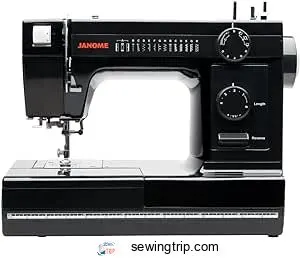
The Janome HD1000BE‘s all-black design highlights its reliability and sturdy construction.
It handles thick fabrics like denim and leather effortlessly, thanks to its heavy-duty build and accessories like the walking foot and ultra glide foot.
With 14 built-in stitches, including a four-step buttonhole, this machine balances simplicity and versatility.
Manual thread tension and the needle down feature guarantee precision, while its compact size makes it easy to store.
Offering a 25-year warranty, it’s perfect for tackling demanding sewing projects confidently.
Best For: Sewing enthusiasts and DIYers who need a reliable, heavy-duty machine for thick fabrics and general sewing projects.
- Thread wrapping around the bobbin casing might cause issues.
- Plastic edges and greasy residue reported by some users.
- Limited protective case doesn’t shield against dust.
- Durable design handles thick fabrics like denim and leather effortlessly.
- 14 built-in stitches, including a four-step buttonhole, offer versatility.
- Compact size with a sleek all-black design for easy storage.
5. JUKI TL 2000Qi Sewing Quilting Machine
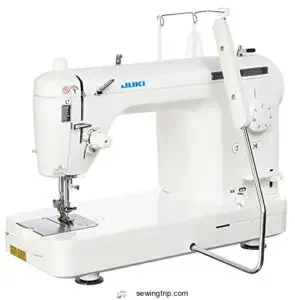
If you need a machine designed for precision, the JUKI TL 2000Qi straight-stitch sewing and quilting machine is a superior choice.
It’s built with an industrial-quality aluminum die-cast frame that minimizes vibrations, making it perfect for heavy fabrics and quilting.
With a blazing speed of 1,500 stitches per minute, an extension table, and compatible high shank presser feet, it’s versatile and efficient.
The automatic thread cutter and LED lighting simplify tasks, while its portable design lets you tackle projects almost anywhere.
Best For: Quilters and heavy-duty sewing enthusiasts looking for a high-speed, straight-stitch machine with industrial-quality performance.
- High-speed stitching at 1,500 SPM for efficiency.
- Aluminum die-cast frame reduces vibration for precise sewing.
- Portable design with an extended work area for larger projects.
- Limited to straight stitches only; no decorative options.
- Requires manual oiling for maintenance before each use.
- Free motion quilting foot sold separately.
6. SINGER 4432 Heavy Duty Sewing Machine
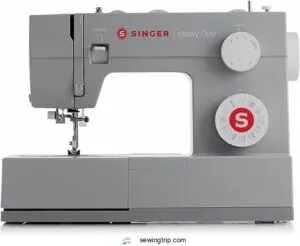
The SINGER 4432 Heavy Duty Sewing Machine is built to tackle thick fabrics effortlessly.
With a robust metal frame and a 60% stronger motor, it powers through denim and canvas with up to 1,100 stitches per minute.
Its 32 built-in stitches, including stretch and decorative options, offer versatility for various projects.
A durable design guarantees long-term use, while features like a jam-proof bobbin system and adjustable presser foot add convenience.
If you demand reliability and speed, this machine won’t disappoint.
Best For: Individuals who need a powerful, durable sewing machine for handling heavy fabrics like denim and canvas.
- 60% stronger motor for thick fabrics.
- High sewing speed of up to 1,100 stitches per minute.
- Durable metal frame for long-term stability.
- Heavier design may limit portability.
- High sewing speed could require practice for precision.
- Mixed user reviews on quality compared to older models.
Heavy Duty Sewing Machine Features
When working with thick fabrics, you need a sewing machine designed for strength and precision.
Key features like a metal frame, a powerful motor, and compatibility with heavy-duty needles guarantee smooth, consistent stitching across multiple layers, which is crucial for achieving professional results with precision.
Metal Frame Construction
A metal frame is essential for a durable sewing machine.
It guarantees frame durability, vibration reduction, and long-term stability.
The strong sewing machine design keeps component alignment steady for smooth stitches.
Plus, a metal interior frame handles thick fabrics confidently.
Look for:
- Frame durability for heavy projects
- Vibration reduction for steady stitching
- Long-term stability
- Improved weight impact
- Consistent component alignment to ensure smooth stitches.
Powerful Motor for Thick Fabrics
A powerful motor makes a big difference when sewing thick fabrics.
Heavy-duty sewing machines with high Motor Ampere deliver consistent power, maintaining strong performance even with tough materials.
Industrial models excel here, offering rapid sewing speeds without strain.
Many users look to upgrade their machine with a replacement sewing motor.
Pair this with proper needle compatibility for smooth stitching and reliable results, even on multi-layered projects.
It’s efficient and frustration-free!
Ability to Sew Multiple Layers
When tackling thick fabrics, a heavy duty sewing machine excels at handling multiple layers.
Fabric layer capacity depends on feed dog efficiency and motor power. Strong feed dogs grip layers tightly, ensuring smooth movement without skipped stitches.
Stitch quality impacts durability, while needle stress factors require sturdy needles. A machine’s sewing power guarantees consistent results, even with tough materials.
These machines often feature a powerful motor to handle the extra strain, making them ideal for working with tough materials.
Compatible Needle Systems
A heavy duty sewing machine needs the right needle to handle thick fabrics effortlessly.
Use these tips to pick the best needle system:
- Choose universal needles (90/14 to 110/18) for varying fabric thickness.
- Select topstitch needles for heavy threads.
- Match thread compatibility for smoother stitches.
- Use jeans needles for denim.
For sewing denim, consider specialized needle options.
- Avoid breakage by following sewing machine guidelines to ensure a smooth sewing experience.
Helpful Accessories and Settings
When tackling thick fabrics, the right accessories and settings can make all the difference.
Features like speed control, a walking foot, and an extension table help you sew smoothly and with precision.
Speed Control for Precision
Speed control is a game-changer for tackling thick fabrics.
A reliable variable speed setting, combined with foot pedal precision, guarantees smoother stitching.
Industrial sewing machines with motor control offer consistent stitch quality, even with heavy-duty projects.
Adjusting sewing speed helps avoid fabric bunching, giving you better handling and precise results.
Perfect for delicate adjustments or powering through dense materials effortlessly, with a reliable variable speed setting.
Automatic Needle Threader for Ease
An automatic needle threader is a game-changer for saving time and avoiding frustration.
It simplifies threading, especially when working with thick fabrics. You’ll love how it enhances sewing machine features for smooth operation.
- Threader Benefits: Speeds up threading for quicker starts.
- Threader Compatibility: Works seamlessly with most sewing machines for thick fabrics.
- Threader Maintenance: Easy cleaning guarantees long-term reliability.
Walking Foot for Even Feeding
A walking foot guarantees fabric grip and stitch consistency when working with thick fabrics.
It synchronizes with your sewing machine’s feed dogs, preventing slippage on heavy materials.
Ideal for quilting or layered projects, this attachment adjusts foot pressure for smooth feeding.
For those seeking specialized walking feet, many options are available.
Whether using an industrial sewing machine or heavy-duty model, it’s a game-changer for difficult material types, providing smooth feeding.
Extra High Presser Foot Lift for Thick Fabrics
For sewing thick fabrics, an extra high presser foot lift is a game-changer.
It boosts fabric clearance, making bulky material compression a breeze.
The lift mechanism guarantees smooth passes under the presser foot, even with heavy-duty sewing machines.
Pair it with controlled foot pressure, and you’ve got the ideal setup for tackling tough projects seamlessly.
Extension Table for Large Projects
An extension table is a game-changer for large sewing projects.
It enhances workspace, supporting heavy fabrics and distributing weight evenly for stability.
You’ll find ergonomic benefits that make quilting or handling bulky materials easier.
A sewing machine extension substantially increases workspace.
- Steady Fabric Support: Keeps layers aligned during sewing.
- Better Weight Distribution: Prevents fabric drag.
- Increased Project Size Capacity: Ideal for quilting and larger pieces.
Sewing Thick Fabrics Successfully
Sewing thick fabrics takes the right preparation and technique to get professional results without headaches.
By setting up your machine correctly and using the proper tools, you’ll avoid common issues like skipped stitches or fabric bunching, which is crucial for achieving professional results and preventing headaches.
Preparing The Fabric and Machine
Before diving in, give your fabric a quick pre-treatment—wash and iron it to remove wrinkles.
Check your heavy-duty sewing machine for smooth operation by cleaning lint and oiling parts. Adjust the thread tension and install the correct needle. Use the presser foot that guarantees stability.
Here’s a quick prep checklist:
| Task | What to Check | Why It Matters |
|---|---|---|
| Fabric Pre-treatment | Washed and ironed | Prevents puckering |
| Needle Selection | Correct needle size/type | Avoids breakage on thick fabrics |
| Machine Maintenance | Clean and oiled machine | Ensures smooth operation |
The provided checklist is crucial for ensuring that your sewing project starts on the right foot, with a well-prepared fabric and a properly maintained machine.
Selecting The Right Needle and Thread
Choosing the right needle and thread affects stitch quality on thick fabrics.
Use needles sized for heavy materials, like denim or jeans needles, to prevent breaking. Match thread type to fabric compatibility, opting for durable polyester or nylon.
Check thread thickness aligns with the needle size to avoid skipped stitches. Proper needle-thread pairing enhances sewing techniques on any machine.
Domestic machines use the 705/130H needle system.
Adjusting Machine Settings for Thick Fabrics
Tweaking your machine makes all the difference with thick fabrics.
Start with tension adjustment—too tight, and stitches may snap. Adjust the stitch length for longer, even stitching.
Use the pressure foot to handle bulk without forcing it. Check the feed dog grips the material smoothly.
These sewing machine settings guarantee precise results every time, no frustration required!
Techniques for Smooth and Even Stitching
To sew thick fabrics smoothly, use a walking foot for even feeding.
Adjust tension and feed dog settings for stability. Increase stitch length slightly to avoid bunching.
Reduce presser foot pressure to ease fabric movement, and pair this with proper needle selection for thick fabrics.
Try these sewing machine techniques, and you’ll get clean, professional results effortlessly!
Troubleshooting Common Issues With Thick Fabrics
When dealing with thick fabrics, skipped stitches or needle breakage often stem from using the wrong needle—switch to a heavy-duty needle.
Fabric bunching and tension problems? Check thread tension and re-thread the machine to prevent thread jams.
For uneven feeding, clean feed dogs, use a walking foot, and adjust settings.
Proper sewing machine troubleshooting is key to avoiding frustrations.
Frequently Asked Questions (FAQs)
What is the best sewing machine for sewing thick fabric?
The Juki TL-2010Q stands out for thick fabrics, thanks to its steady metal build, 1,500 SPM speed, and vibration-free operation.
Its extra-high presser foot and extension table handle bulky materials effortlessly, making it a great choice for thick fabrics.
Can a regular sewing machine sew thick fabric?
Sure, regular sewing machines can handle thick fabrics—sometimes.
But don’t expect miracles.
With the right needle, slow speed, and patience, it’s doable.
Still, heavy-duty machines are built for the job, frustration-free.
What sewing machine needle is best for thick fabric?
For thick fabrics, use a heavy-duty needle, like a size 16/100 or 18/ These needles are strong enough to pierce through dense materials without bending or breaking, ensuring clean, consistent stitches.
How do I maintain heavy-duty sewing machines?
Funny how machines seem tougher than humans, yet they need care too.
Keep your heavy-duty sewing machine clean, oiled, and lint-free, check tension regularly, replace needles often.
And don’t skip the manual’s maintenance schedule.
What fabrics qualify as thick and challenging?
Fabrics like denim, canvas, leather, upholstery, and multilayered quilts are considered thick and challenging.
They require strong needles, high pressure settings, and steady equipment to handle their dense fibers without skipping or breaking stitches.
Are computerized machines better for thick fabrics?
Computerized machines can handle thick fabrics, but not always better than mechanical ones.
Advanced features like stitch editing help precision, yet their motors might lack power.
For thick materials, a high-powered mechanical machine often outperforms.
How to prevent thread snags with thick fabrics?
Think of thread tension like a recipe—you need balance.
Adjust tension slightly lower, use heavy-duty needles and thread, and always test scraps first.
Guide fabric gently, keeping spool and bobbin clean for smooth stitching.
Which presser feet are best for layers?
Use a walking foot for even feeding, a zipper foot for tight spaces, or a Teflon foot to prevent sticking on tough fabrics.
These options guarantee smooth stitching through multiple layers with less frustration.
Conclusion
Mastering thick fabrics is like opening a sturdy door—you need the right key, or in this case, the perfect sewing machine for thick fabrics.
With features like a powerful motor, metal frame, and essential accessories, these machines are built to handle the toughest materials.
By following the tips shared here and choosing a model from the top six options, you’ll sew through challenging layers with ease, and transform heavy-duty sewing into a seamless experience!
- https://en.wikipedia.org/wiki/Sewing_machine
- https://haberdasherbee.co.uk/blog/choosing-needle-thread/?srsltid=AfmBOor12L6YwddmS57SwUkJw218I95MBvhvc1UtsnEivcwoYc2d8qnT
- https://corefabricstore.com/blogs/tips-and-resources/how-to-choose-the-perfect-machine-needle-for-your-next-sewing-project?srsltid=AfmBOoo0ywmRTkhKZlSrmBDCX-CF-0-Ybp7dQsE6FN28AKiryaekAHWJ
- https://www.blog.wawak.com/post/sewing-machine-needle-and-thread-size-chart
- https://www.sewessential.co.uk/blog/how-to-choose-the-right-sewing-machine-needle/

